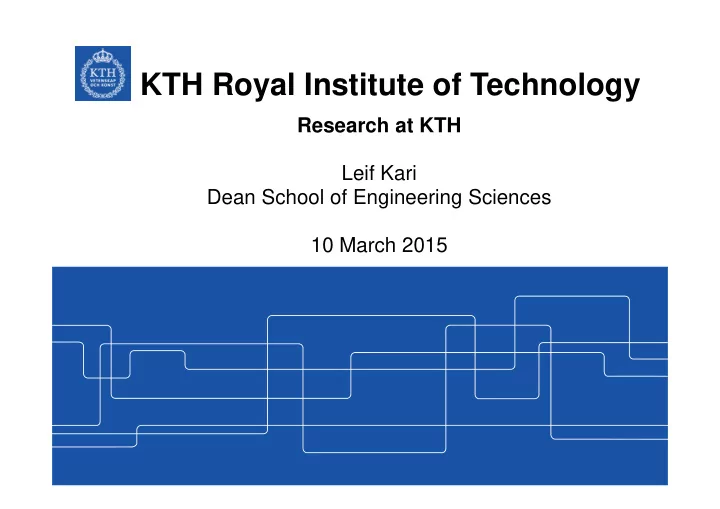

KTH Royal Institute of Technology Research at KTH Leif Kari Dean School of Engineering Sciences 10 March 2015
Sweden's leading university of technology • Sweden's oldest and largest university of technology. • More than 12,000 full-time (equivalents) students. • More than 1,800 PhD students. • Over 4,800 employees. • Ranked as the 126th best university in the world by THE • Ranked as the 30th best univ. of technology in the world by THE 2
President Obama visits KTH September 4th 2013
KTH’s organisation University Board University Faculty President Administration Council Architecture and the Built Environment Electrical Engineering Biotechnology Engineering Sciences Chemical Science and Engineering Industrial Engineering and Management Computer Science and Communication Information and Communication Technology Education and Communication in Engineering Technology and Health Science
KTH research platforms Transport Energy Climate and Materials KTH ICT Science Life
Sources of income 2013 Income total MSEK 4,038 = M$484 Level 1 and level 2 education 23.7% (26%) Research and doctoral studies grants 26.4% (25%) Research Councils 9.8% (9.6%) Other government agencies 16.5% (15.7%) Strategic foundations 2.4% (2.3%) EU 7% (7.4%) Other private sources/companies 14.2% (14%)
KTH - An international university International KTH faculty and researchers Worldwide student exchange International students (degree-seeking) International collaboration • CLUSTER • 4 KICs • China Centres of Excellence • INSPIRE Illinois • Students, staff and alumni from more than 100 countries • International collaboration initiatives…
Collaboration with society Strategic partnerships Long-term dialogue on executive level Short-term goals for education and research Mobility Adjoint professors, affiliated faculty, industry PhD students Adjoint experts, affiliated experts
School of Engineering Sciences Rektor Organization: School School advisory Dean Administration board Applied physics Aeronautical and Vehicle Physics Engineering Theoretical physics Solid Mechanics Mathematics Mechanics
Department of Theoretical Physics Particle and mathematical Condensed matter physics physics Biophysics Olle Edholm Anders Rosengren Tommy Ohlsson Alexander Balatsky Erik Lindahl Mats Wallin Patrik Henelius Edwin Langmann
Department of Theoretical physics BIOPHYSICS Membrane and membrane protein modeling Bioinformatics and structure predicition In silico drug design Molecular simulation(GROMACS, Folding at home) Soft condensed matter CONDENSED MATTER PHYSICS New types of superconductivity Materials at high T and P. Structure of the earth core Copper corrosion and nuclear waste disposal Spin models Disordered systems, Dirac materials PARTICLE AND MATHEMATICAL PHYSICS Neutrino physics Dark matter, extra dimensions Exactly solvable models 2D correlated Fermion systems Quantum field theory; Open quantum systems
Applied Physics: Bio-Opto-Nano & Teaching Biomedical & X-Ray Physics (28 p) Cell Physics (19 p) Biomolecular Physics (11 p) X-rays (sources, microscopy, imaging), Microscopy, protein interaction, cell Single molecules, fluorescence, ultrasonics, cell biology, visual optics biology, modeling, immunology microscopy Antibunching 1 mm 100 mm fibercontact wire Quantum Laser Physics (22 p) Nanostruct. Physics (9 p) Undergr. Teaching Electr./Opt. (8 p) Optical materials, non-linear optics, Quantum circuits, spintronics, nano- Electomagn. & waves, Quantum information, functional light sources bio surfaces, AFM bio- opto- nano- courses… quantum mech.
APHYS Integrated Laboratory Environment 100 users, 1200 m 2 Core facilities (500 m 2 ) Specialized labs (700 m 2 ) Laser- and Non-Linear Optics Nanofabrication Bioimaging 1 mm 100 mm Molec. & Cell Biology
Department of Physics Head of Department: Mark Pearce
Physics of medical imaging: Detector systems for Nuclear physics: Nuclear structure studies at the better images and lower radiation doses. (Prof. M. limits of existence (experiment and theory). Danielsson). Preparations for FAIR facility. (Prof B. Cederwall, Prof. R. Wyss) Astroparticle physics: Cosmic antimatter and (polarised) X- /gamma-rays. Balloon and satellite-borne instruments. Particle physics: ATLAS experiment at LHC. (Prof. M. Pearce) Higgs and supersymmetry. (Prof. B. Lund-Jensen)
Reactor physics: Generation IV reactors for Reactor technology: Computational (CFD) and experimental reactor transmutation of nuclear waste. (Prof. J. thermal-hydraulics and neutronics. (Prof. H. Anglart) Wallenius, Prof. W. Gudowski) Nuclear Power Safety: reactor/plant safety design and analysis, experimental studies, multiscale modelling. (Prof. S. Bechta)
Nobel Prize in Physics 2013
Recommend
More recommend